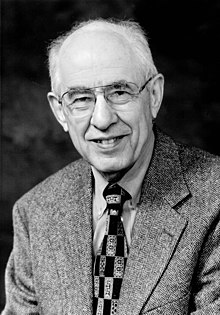Hilary Whitehall Putnam (/ˈpʌtnəm/; July 31, 1926 – March 13, 2016) was an American philosopher, mathematician, computer scientist, and figure in analytic philosophy in the second half of the 20th century. He contributed to the studies of philosophy of mind, philosophy of language, philosophy of mathematics, and philosophy of science.[5] Outside philosophy, Putnam contributed to mathematics and computer science. Together with Martin Davis he developed the Davis–Putnam algorithm for the Boolean satisfiability problem[6] and he helped demonstrate the unsolvability of Hilbert's tenth problem.[7]
Putnam applied equal scrutiny to his own philosophical positions as to those of others, subjecting each position to rigorous analysis until he exposed its flaws.[8] As a result, he acquired a reputation for frequently changing his positions.[9] In philosophy of mind, Putnam argued against the type-identity of mental and physical states based on his hypothesis of the multiple realizability of the mental, and for the concept of functionalism, an influential theory regarding the mind–body problem.[5][10] In philosophy of language, along with Saul Kripke and others, he developed the causal theory of reference, and formulated an original theory of meaning, introducing the notion of semantic externalism based on a thought experiment called Twin Earth.[11]
In philosophy of mathematics, Putnam and W. V. O. Quine developed the Quine–Putnam indispensability argument, an argument for the reality of mathematical entities,[12] later espousing the view that mathematics is not purely logical, but "quasi-empirical".[13] In epistemology, Putnam criticized the "brain in a vat" thought experiment, which appears to provide a powerful argument for epistemological skepticism, by challenging its coherence.[14] In metaphysics, he originally espoused a position called metaphysical realism, but eventually became one of its most outspoken critics, first adopting a view he called "internal realism",[15] which he later abandoned. Despite these changes of view, throughout his career Putnam remained committed to scientific realism, roughly the view that mature scientific theories are approximately true descriptions of ways things are.[16]
In his later work, Putnam became increasingly interested in American pragmatism, Jewish philosophy, and ethics, engaging with a wider array of philosophical traditions. He also displayed an interest in metaphilosophy, seeking to "renew philosophy" from what he identified as narrow and inflated concerns.[17] He was at times a politically controversial figure, especially for his involvement with the Progressive Labor Party in the late 1960s and early 1970s.[18]
- ^ "Pragmatism". Internet Encyclopedia of Philosophy. Archived from the original on August 12, 2022. Retrieved August 18, 2022.
- ^ a b Hilary Putnam at the Mathematics Genealogy Project
- ^ Putnam, Hilary (1978). ""Realism and reason", Presidential Address to the Eastern Division of the American Philosophical Association, December 1976". Meaning and the Moral Sciences. Routledge and Kegan Paul. pp. 123–140. ISBN 978-0-710-08754-6. OCLC 318417931.
- ^ van Fraassen, Bas (1997). "Putnam's Paradox: Metaphysical Realism Revamped and Evaded" (PDF). Philosophical Perspectives. 11: 17–42. JSTOR 2216123.
- ^ a b Casati, R. (2004). "Hillary Putnam". In Vattimo, Gianni (ed.). Enciclopedia Garzanti della Filosofia. Milan: Garzanti Editori. ISBN 88-11-50515-1.
- ^ Davis, M.; Putnam, H (1960). "A computing procedure for quantification theory". Journal of the ACM. 7 (3): 201–215. doi:10.1145/321033.321034. S2CID 31888376.
- ^ Matiyesavic, Yuri (1993). Hilbert's Tenth Problem. Cambridge: MIT. ISBN 0-262-13295-8.
- ^ King, P. J. (2004). One Hundred Philosophers: The Life and Work of the World's Greatest Thinkers. Barron's. p. 170. ISBN 978-0-764-12791-5. OCLC 56593946.
- ^ Ritchie, Jack (June 2002). "TPM: Philosopher of the Month". Archived from the original on July 9, 2011.
- ^ LeDoux, J. (2002). The Synaptic Self: How Our Brains Become Who We Are. New York: Viking Penguin. ISBN 88-7078-795-8.
- ^ Clark, Peter; Hale, Bob, eds. (1995). Reading Putnam. Cambridge (Massachusetts), Oxford: Blackwell. ISBN 978-0-631-19995-3. OCLC 35303308.
- ^ Colyvan, Mark (Spring 2019). "Indispensability Arguments in the Philosophy of Mathematics". In Zalta, Edward N. (ed.). Stanford Encyclopedia of Philosophy.
- ^ Putnam, H. (1964). Benacerraf, Paul (ed.). Philosophy of Mathematics: Selected Readings. Englewood Cliffs, N.J.: Prentice-Hall. OCLC 1277244158. 2nd ed., Cambridge: Cambridge University Press, 1983.
- ^ Putnam, H. (1981). "Brains in a vat" (PDF). Reason, Truth, and History. Cambridge University Press. ISBN 978-0-521-23035-3. OCLC 442822274. Archived from the original (PDF) on October 6, 2021. reprinted in DeRose, K.; Warfield, T. A., eds. (1999). Skepticism: A Contemporary Reader. Oxford University Press. ISBN 978-0-195-11826-1. OCLC 1100897197.
- ^ Putnam, H. (1990). Conant, J. F. (ed.). Realism with a Human Face. Cambridge, Massachusetts: Harvard University Press. ISBN 978-0-674-74945-0. OCLC 1014989000.
- ^ Putnam, H. (2012). "From Quantum Mechanics to Ethics and Back Again". In De Caro, M.; Macarthur, D. (eds.). Philosophy in an Age of Science. Cambridge, Massachusetts: Harvard University Press. ISBN 978-0-674-05013-6. OCLC 913024858.
- ^ Putnam, Hilary (2015). Auxier, R. E.; Anderson, D. R.; Hahn, L. E. (eds.). The Philosophy of Hilary Putnam. Chicago: Open Court. ISBN 978-0-8126-9898-5. OCLC 921843436.
- ^ Foley, M. (2003). Confronting the War Machine: Draft Resistance during the Vietnam War. Chapel Hill, North Carolina: North Carolina Press. ISBN 0-8078-2767-3.
